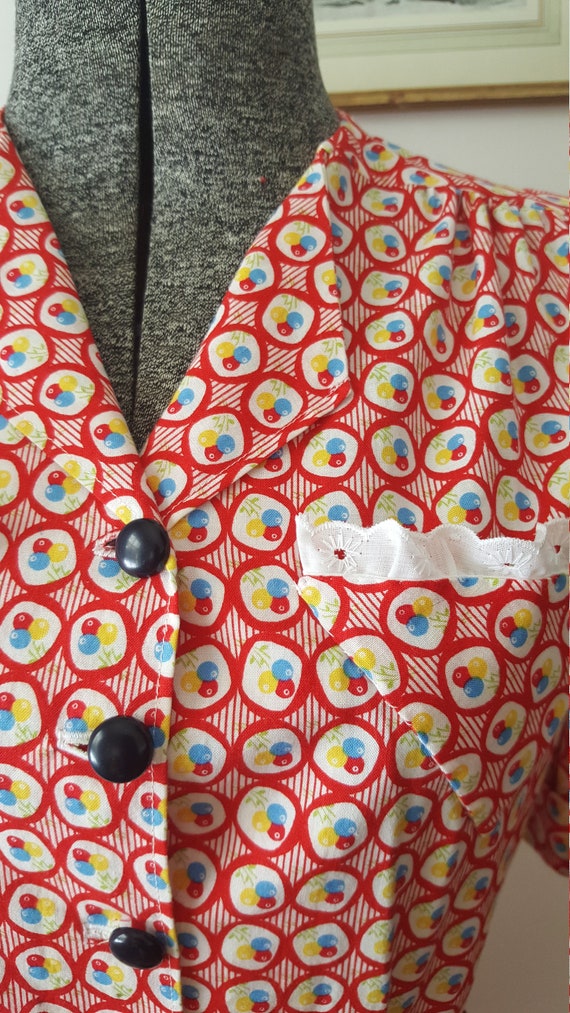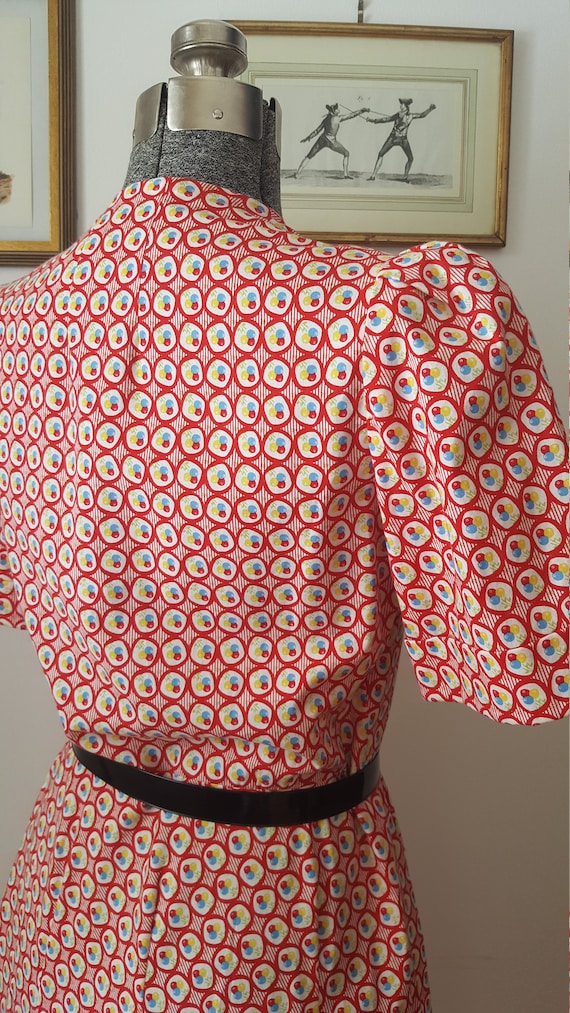Sunday, November 21, 2021
A New and Exciting Business Endeavor
As many of you may know, I purchased At the Sign of the Golden Scissors and Larkin & Smith sewing pattern line back in August. I've been working hard all year to achieve this goal and I'm so excited by the many possibilities this endeavor offers in allowing me to continue sharing my love of sewing, research and creativity with a wider audience and in a more official capacity than I have been able to do in the past. This will benefit living history peeps as well as historical costumers!
I am working diligently to reprint each of the beloved Larkin & Smith 18th century sewing patterns, starting with the English Gown and the Front and Back Lacing Stays. As we head into the holiday shopping season I will be adding more items to the website, many of them will be new Old Stock items from the former owners.
What does all this mean for Emily's Vintage Visions?
Well, starting next year I will begin incorporating my vintage style reproductions and curated collection of true vintage and antique items for sale on the Golden Scissors website. How exciting to be able to combine a love of historical and vintage sewing under one roof! My Instagram accounts and Facebook pages for
Emily's Vintage Visions and At the Sign of the Golden Scissors will remain as they are - independent of each other - so you will be able to follow one or both as you choose.
What's Next?
MARK YOUR CALENDARS!
Schedule for listing Black Friday and Small Business Saturday Specials!! New items will be listed each day starting at 8am EST so check back often.
11/23/21 - Pin Cushions and Pin Balls
11/24/21 - Books, Odds & Ends
11/25/21 - New Old Stock Cap patterns and kits
11/26/21 - New Old Stock Embroidery kits, crewel yarn bundles
11/27/21 - New Old Stock Fashionable Gown patterns
Please note availability of certain items is very limited. In most cases there will only be one or two of each item. We will do our best to combine shipping when possible.
Friday, August 6, 2021
Big Announcement Coming Soon!
Hello everyone! I know it's been ages since I last posted anything on my blog. However, I will have a big announcement coming soon that I hope will be as exciting to the living history and historical costuming communities as it is to me. I have big plans and I can't wait to share them with you so stay tuned!
My Etsy shop is currently set to vacation mode. I will be moving future listing to a new platform.
Friday, July 31, 2020
How To Refill a Vintage Compact
Before you even think about refilling your vintage compact, you need to clean it. If there is any old makeup present, it can harbor dust, bacteria, and potential irritants. Yuck!! Use hot soapy water. Q-tips and small tooth brushes can be helpful to thoroughly clean the inside of your vintage compact. To sanitize your compact soak a cotton ball with rubbing alcohol and wipe the inside. Then rinse with warm water and set aside to dry.
Take care with certain vintage compacts as the mirrors can come loose and will need to be re-glued. Also some compacts have rhinestones or other special details or finished that should not be submerged in water. If that's the case you might want to consider refilling a different compact. However, if you are careful these can still be cleaned, refilled and enjoyed.
So, here is what you are going to need:
- Rubbing alcohol
- Loose powder or pressed powder in your choice of color
- Freshly cleaned vintage compact - Scrap of cheesecloth or linen fabric (optional)
- Small bowl to mix powder
- Butter knife or piece of stiff paper/card stock
- Small spoon
In a small, clean bowl, spoon in some loose powder or you can use a butter knife to scrape out your pressed powder from a modern compact.
Using a small spoon, slowly mix a little rubbing alcohol (about a cap full) with the powder until you form a creamy paste. Don't add too much liquid to start or you will end up with a soupy mess! It's better to add a tiny amount first and add more as needed. Be sure to smooth out any lumps as you mix.
Scoop the paste into vintage compact pan and gently press into place with the back of your spoon. Smooth out any irregularities with your knife or stiff paper/card stock. Be sure not to overfill your compact. Use a cotton ball or q-tip to clean up the edges of your compact.
This next step is optional but makes a nice finish to your powder. Take a scrap cheesecloth or linen fabric and gently press over the compact. Remove. The cloth will create a nice surface look and help smooth powder.
Keep the compact open and allow to dry overnight. Before attempting to use your newly filled vintage compact, make sure the surface is dry by wiping a finger across it. When the compact is ready to use it should feel 'powdery' and smooth.
That's it!
Take care with certain vintage compacts as the mirrors can come loose and will need to be re-glued. Also some compacts have rhinestones or other special details or finished that should not be submerged in water. If that's the case you might want to consider refilling a different compact. However, if you are careful these can still be cleaned, refilled and enjoyed.
So, here is what you are going to need:
- Rubbing alcohol
- Loose powder or pressed powder in your choice of color
- Freshly cleaned vintage compact - Scrap of cheesecloth or linen fabric (optional)
- Small bowl to mix powder
- Butter knife or piece of stiff paper/card stock
- Small spoon
In a small, clean bowl, spoon in some loose powder or you can use a butter knife to scrape out your pressed powder from a modern compact.
Using a small spoon, slowly mix a little rubbing alcohol (about a cap full) with the powder until you form a creamy paste. Don't add too much liquid to start or you will end up with a soupy mess! It's better to add a tiny amount first and add more as needed. Be sure to smooth out any lumps as you mix.
Scoop the paste into vintage compact pan and gently press into place with the back of your spoon. Smooth out any irregularities with your knife or stiff paper/card stock. Be sure not to overfill your compact. Use a cotton ball or q-tip to clean up the edges of your compact.
This next step is optional but makes a nice finish to your powder. Take a scrap cheesecloth or linen fabric and gently press over the compact. Remove. The cloth will create a nice surface look and help smooth powder.
Keep the compact open and allow to dry overnight. Before attempting to use your newly filled vintage compact, make sure the surface is dry by wiping a finger across it. When the compact is ready to use it should feel 'powdery' and smooth.
That's it!
Monday, July 1, 2019
So You Want to be a WAVES Reenactor
So you want to be a WAVES reenactor. How do you start building an impression? Where do you get your uniform? What do you need to get started? What are some basic resources? This blog post, along with the rest of my summer WAVES series, will help you get started.
How to Build an Accurate WAVES Living History Impression.
Before we dive in, let me start by saying this as a bit of a disclaimer. I won't lie to you, or try and sugar coat things. Building a WAVES impression, or any women's WWII military impression for that matter, is NOT CHEAP. Before you buy anything, I urge you to do tons of research, ask lots of questions and shop around. (It took me nearly three years to track down all the pieces I needed for the standard blue uniform.) Unlike other women's WWII impressions, no one is reproducing WAVES uniforms. That means almost everything you need for your uniform will be the real deal. (I see this as both good and bad, but more on that later.) It means tracking down a uniform that not only is your size, but also in good enough condition to be worn. These items are 70+ years old after all!
A full uniform, i.e. the standard blue jacket (sometimes called a tunic) and matching skirt, hat, tie, and blouse can cost somewhere in the neighborhood of $200 to $350. Add shoes (vintage or repro) and the purse and you are talking another $200 easily. (I've seen the purses alone sell between $100 and $300 depending on the seller and condition of the purse.) For some reason the prices on Ebay for WAVES items have sky rocketed in recent years! Some of the most sought after pieces, such as the seersucker uniforms and the summer whites, have sold for ridiculous prices. This is where shopping around, networking with others in the know, and setting yourself a budget can be really helpful. Don't despair, because in time the right pieces will find you!!
- - I don't say any of this to scare people away from the impression, I just want to be as honest and upfront as I can. I hate seeing new people in the hobby spend their hard earned money on incorrect items or things that just can't be used.
Don't fear! There ARE ways that you can portray a WAVE that won't break the
piggy bank. - -
So, let's get started!!
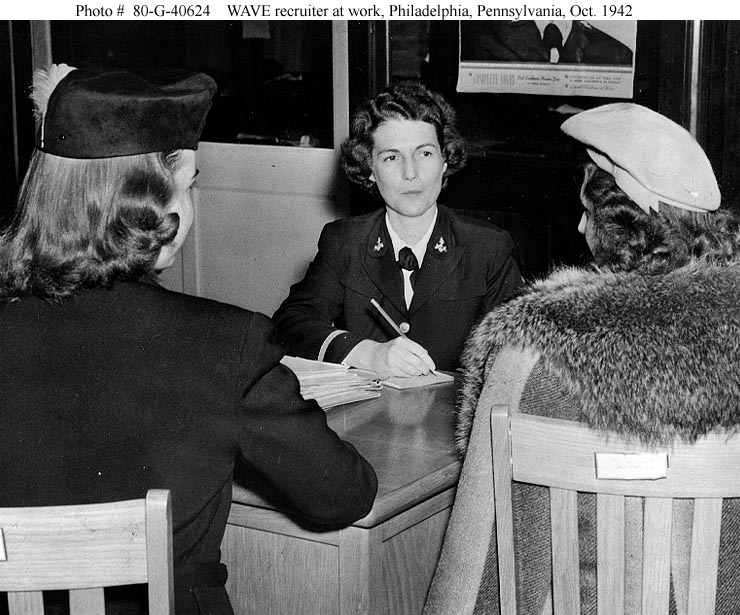 |
| Source - Photo #: 80-G-40624 WAVES recruiting activities Ensign May Herrmann talks to two young women concerning enlistment in the Navy Women's Reserve, at the Officer Procurement office, Philadelphia, Pennsylvania, 30 October 1942. Official U.S. Navy Photograph, now in the collections of the National Archives. |
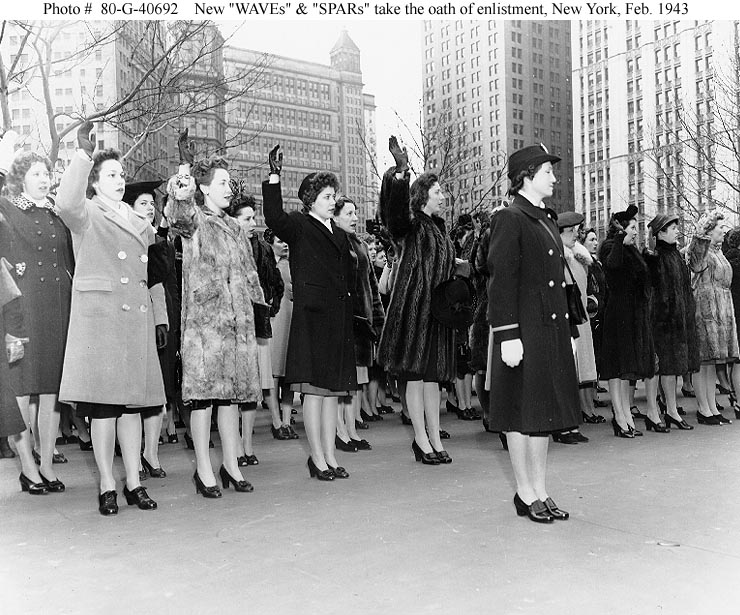 |
| Source - Photo #: 80-G-40692 "WAVES and SPARS Day", New York City New WAVES and SPARS take the oath of enlistment in a ceremony held in front of New York City Hall, 8 February 1943. Official U.S. Navy Photograph, now in the collections of the National Archives. |
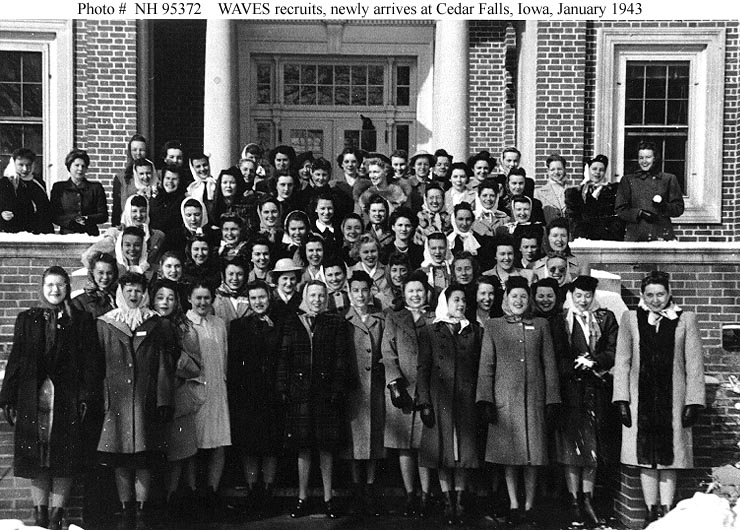 |
| Source - Photo #: NH 95372 Navy WAVES training school, Iowa State Teachers College, Cedar
Falls, Iowa Newly-arrived WAVES recruits pose for a group portrait at the school, before the arrival of their uniforms, January 1943. Shirley Feldstein (Bell) is 3rd from right in the front row, with a white name tag visible on her coat. She comments, on the reverse of the original print: "We all look like penguins ready for a slide in the snow". Donation of Shirley Feldstein Bell. U.S. Naval Historical Center Photograph. |
The easiest and least expensive way to start your WAVES impression is to wear 1940s civilian clothing along with an enlistment pin. The shop Peachy Keen sells them for a few dollars. (They also sell a bunch of other cool stuff so be sure to look through the whole shop!) If you have an interest in WWII reenacting, chances are you already have a basic 1940s outfit. If not, start with a pair 1940s style high waist pants or an A line skirt and a basic 1940s blouse. Add some basic accessories and you are on your way!
If you sew, I highly recommend Wearing History's Smooth Sailing Togs. Go with the e-pattern if you are really on a budget. A simple, but well put together civilian outfit, with a handful of period correct accessories, will take you a long way and will work for many WWII era living history impressions.
By adding a WAVES enlistment pin, you can portray a new WAVES recruit on your way to basic training while you continue your research and save up for those first uniform pieces!
 |
| Smooth Sailing Trousers (shown with Smooth Sailing Blouse AND Blouse from Sailor Girl Playsuit) Sports Togs Paper Pattern: http:// Epattern: Sports Togs A: http:// Sports Togs B: http:// |
| Pins available through Peachy Keen |
The best option on the market right now for reproduction oxfords are the O.A.O. Oxfords from All Heels on Duty. The are a direct copy of WWII women's military footwear, are solidly made, and super comfortable. These will serve you well for everyday vintage wear as well as both your 1940s civilian and military impressions. (I hear their next style will be the military heeled pumps!!)
 |
| Imaging showing a WAVE polishing her standard issued oxfords. |
 |
| Style A is want you want to look for, though a slightly lower heel would be good. Image from Glamourdaze |
Early war ties for the WAVES are two pieces and button at the sides of the neck under the collar. You can add these buttons to a new blouse in a flash. Another thing to keep in mind if you are on a tight budget is that your reproduction white blouse and shoes can double for civilian wear! Score!
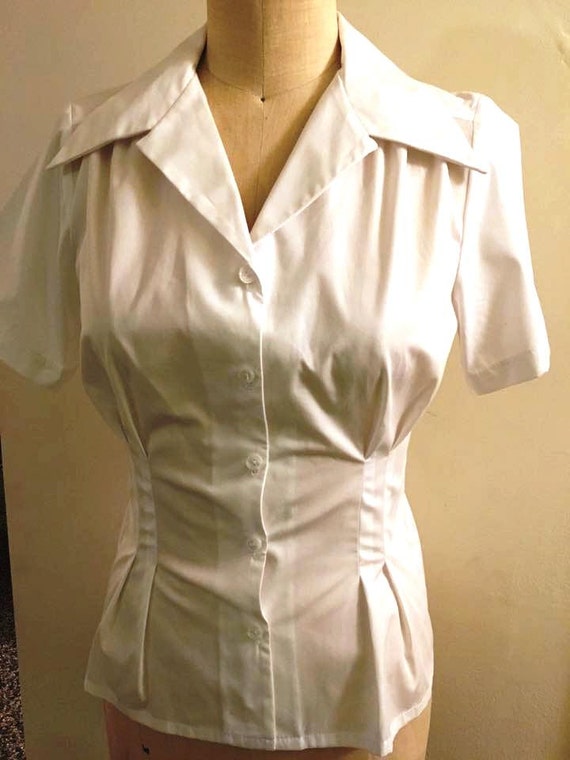 |
| Blouse from Nudeedudee on Etsy |
Notes on Sewing Your Own Uniforms
There are no patterns on the market for WAVES uniforms, though a highly skilled seamstress can draft patterns from originals.
As these are military uniforms, the materials used and construction details are very specific! Finding the correct materials for the blue wool uniforms and the cotton seersucker uniforms will be challenging but not completely impossible. I highly recommend examining originals (or high res photos) to gather information about the cut/fit and fabrics used. Invest in an original hat (overseas/garrison or soft crown with the WAVES tally), patches for the collar and buttons to complete the look if you are sewing your own inform. These will help immensely with giving an authentic look and feel. You can also take these items with you to fabric stores to help guide your search for fabric. Both the overseas/garrison caps in wool and seersucker, as well as the seersucker rating patches are the same materials as the rest of the uniforms. The blue rating patches for the most part are the same too.
Ordering fabrics online for any sewing project can be frustrating, so I highly recommend ordering fabric swatches first to match the correct color and weave.
----------
I hope this mini introduction into WAVES uniforms is helpful! Our next WAVES post will cover research materials. Future posts will also go into more detail about uniforms, how they are worn and what to look for when shopping for originals!
Have a research question about the WAVES? Ask away!
Sunday, June 16, 2019
Sold But Not Forgotten - Du Barry 2413B
This dress is easily one of my top ten favorites of all the reproduction pieces I've made to sell so far. This super cute 1930s/40s reproduction cotton print was a lucky find at my local fabric shop. (I was also able to find it in a purple colorway as well!) A few of you may remember the first time I used Du Barry 2413B, waaaaay back when I first started sewing 30s/40s clothing for myself. It's a great pattern and one I can see myself sewing a few more times!
It's a fairly basic pattern but it has some great details too. I love the option of the little V-shaped pockets! They make the perfect accent for a war-era dress. While the skirt does have some tiny pin tucks, they are kind of lost in this particular print. I think in a solid fabric they would stand out a bit more.
Here are a few in progress shots on the dress. Another thing I like about this dress are the little pouf sleeves and gathering at the shoulders.
Playing with some trim for the pockets! I ended up using this cotton eyelet. It helped break up the bright red print just bit. I added some dark colored vintage buttons from the stash too for the same reason.
Here are a few photos of the finished dress. I'm very happy with how this one turned out.
My friend Christiana bought the dress and she looks amazing in it! She even wore it for a photo session with A Timeless Collection. Here are a few images from that shoot, shown with permission.
 |
| Photo by A Timeless Collection |
 |
| Photo by A Timeless Collection |
Interested in purchasing a reproduction dress or blouse from me? Have a look at my Etsy shop.
Summary of the Pattern
Fabric: Late 1930s/early 1940s reproduction cotton print
Pattern: Du Barry 2413B
Year: About 1938/39
Notions: Buttons, thread, cotton lace trim
Time to Complete: Start to finish, I'd say about a week. It's an easy pattern to complete in a weekend if you have the time to sit and sew.
How historically accurate is it? Pretty darn close! The pattern is original vintage and the fabric is a historically accurate print. The buttons and lace trim, though vintage, are likely 1950s or 1960s.
Any tricky parts to the pattern? I've made this pattern once before and it goes together pretty easily.
Did you change anything? I chose not to add a side zipper. Instead of adding a collar I just turned but the front edges to form mini lapels.
Fabric: Late 1930s/early 1940s reproduction cotton print
Pattern: Du Barry 2413B
Year: About 1938/39
Notions: Buttons, thread, cotton lace trim
Time to Complete: Start to finish, I'd say about a week. It's an easy pattern to complete in a weekend if you have the time to sit and sew.
How historically accurate is it? Pretty darn close! The pattern is original vintage and the fabric is a historically accurate print. The buttons and lace trim, though vintage, are likely 1950s or 1960s.
Any tricky parts to the pattern? I've made this pattern once before and it goes together pretty easily.
Did you change anything? I chose not to add a side zipper. Instead of adding a collar I just turned but the front edges to form mini lapels.
Labels:
1930s,
1940s,
DuBarry 2413B,
New Shop Listings,
Patterns,
Reviews,
sewing project,
Vintage Sewing
Subscribe to:
Comments (Atom)







